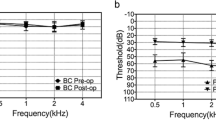Abstract
The objective of this study was to compare the results of hearing augmentation with the Retro-X semi-implantable hearing aid to a conventional non-implantable open canal hearing aid using the same software technology (Titan-X, auric Hearing Systems, HiKaNo.:13.20.03.0047). Nineteen subjects (20 ears) with mild to moderate high-frequency sensory-neural hearing loss were included in this clinical study. All the subjects were first fitted with a conventional open canal hearing aid (Titan-X). After a period of 4–6 weeks audiological evaluations were performed using standardized speech tests in quiet and noise. Subjective evaluation was performed with the help of standardized questionnaires. After this phase the patients received the semi-implantable Retro-X device under local anaesthesia and 4 weeks later were fitted with a hearing module with the same software technology as the conventional Titan-X hearing aid. Four weeks following the first fitting the same audiological evaluations were performed under similar conditions and the patients were evaluated again using the same questionnaires in order to compare the results of the Retro-X semi-implantable system with the conventional open canal hearing aid. Audiological evaluations revealed better results with the semi-implantable Retro-X in the adaptive speech in noise test; however, the results of the monosyllabic word test in quiet were similar for the Retro-X and conventional open canal hearing aid. The patients subjectively preferred the improved wearing comfort of the semi-implantable device. The Retro-X semi-implantable hearing aid provides better speech perception in noise and higher wearing comfort in comparison to the conventional open canal hearing aids. Considering the simple implantation procedure under local anaesthesia with low complication rate, Retro-X is an alternative to the conventional open canal hearing aids in patients with mild to moderate high frequency sensory-neural hearing loss.








Similar content being viewed by others
References
Barbara M, Bandiera G, Serra B, Marrone V, Tarentini S, Pinna JC, Ronchetti F, Graziadio M, Monini S (2005) Digital hearing aids for high-frequency sensorineural hearing loss: preliminary experience with the RetroX device. Acta Oto-Larygol 125(7):693–696
Beamer SL, Grant KW, Walden BE (2000) Hearing aid benefit in patients with high-frequency hearing loss. J Am Acad Audiol 11(8):439–437
Brugel FJ, Schorn K, Fastl H (1991) Effect of venting the ear mould on speech discrimination in masking noise. HNO 39(9):356–361
Cox RM, Alexander GC (1983) Acoustic versus electronic modifications of hearing aid low-frequency output. Ear Hear 4(4):190–196
Cox RM, Alexander GC (2002) The International Outcome Inventory for Hearing Aids (IOI-HA): psychometric properties of the English version. Int J Audiol 41(1):30–35
Cox RM, Stephens D, Kramer SE (2002) Translations of the International Outcome Inventory for Hearing Aids (IOI-HA). Int J Audiol 41(1):3–26
Garin P, Genard F, Galle C, Fameree MH, Jamart J (2005) Rehabilitation of high-frequency hearing loss with the RetroX auditory implant. B-ENT 1(1):17–23
Holube I, Kollmeier B (1991) Ein Fragebogen zur Erfassung des subjektiven Hörvermögens: Erstellung der Fragen und Beziehung zum Tonschwellenaudiogramm. Audiologische Akustik 30:48–64
Holube I, Kollmeier B (1994) Modifikation eines Fragebogens zur Erfassung des subjektiven Hörvermögens und dessen Beziehung zur Sprachverständlichkeit in Ruhe und in Störgeräuschen. Audiologische Akustik 33(4):22–35
Horwitz AR, Dubno JR, Ahlstrom JB (2002) Recognition of low-pass-filtered consonants in noise with normal and impaired high-frequency hearing. J Acoust 111(1):409–416
Kuk FK (1991) Perceptual consequence of vents in hearing aids. Br J Audiol 25(3):163–169
Lundberg G, Ovegard A, Hagerman B, Gabrielsson A, Brandstrom U (1992) Perceived sound quality in a hearing aid with vented and closed earmould equalized in frequency response. Scand Audiol 21(2):87–92
MacKenzie K, Browning GG, McClymoont LG (1989) Relationship between earmould venting, comfort and feedback. Br J Audiol 23(4):335–337
Noble W, Sinclair S, Byrne D (1998) Improvement in aided sound localization with open earmoulds: observations in people with high-frequency hearing loss. J Am Acad Audiol 9(1):25–34
Smoorenburg GF (1992) Speech reception in quiet and in noisy conditions by individuals with noise-induced hearing loss in relation to their tone audiogram. J Acoust Soc Am 91(1):421–437
Sweetow RW, Pirzanski CZ (2003) The occlusion effect and ampclusion effect. Semin Hear 24(4):333–345
Valente M (1996) Hearing aids: standards, options and limitations. Thieme Medical Publishers, New York
Wagener K, Kühnel V, Kollmeier B (1999) Entwicklung und Evaluation eines Satztestes für die deutsche Sprache I: Design des Oldenburger Satztests. Z Audiol 38(1):4–15
Wagener K, Brand T, Kollmeier B (1999) Entwicklung und Evaluation eines Satztestes für die deutsche Sprache II: Optimierung des Oldenburger Satztests. Z Audiol 38(2):44–56
Wagener K, Brand T, Kollmeier B (1999) Entwicklung und Evaluation eines Satztestes für die deutsche Sprache III: Evaluation des Oldenburger Satztests. Z Audiol 38(3):86–95
Wesendahl T (2001) Teilimplantation: RetroX® – Luftleitungshörsystem mit retroaurikulärer Schallführung. In: Biesinger E, Iro H (eds) HNO— Praxis Heute. Springer, Berlin, pp 165–176
Wesendahl T (2006) The insertion procedure, aftercare and soft tissue reaction of the 2.5 mm titanium tube system for a TACHAS. Int Tinnitus J 12(1):3–8
Winter M, Lenarz T (2005) The RetroX semi-implantable hearing system. Cochl Impl Int 6(suppl 1):62–65
Winter M, Wesendahl T (2005) Acoustic properties of a transcutaneous air conduction hearing aid system. Biomed Tech (Berl) 50(suppl 1):42–43
Author information
Authors and Affiliations
Corresponding author
Rights and permissions
About this article
Cite this article
Lenarz, M., Lenarz, T., Stieve, M. et al. A comparative study of the audiological outcomes with Retro-X (semi-implantable hearing aid system) and conventional open fitting hearing aids. Eur Arch Otorhinolaryngol 265, 1189–1194 (2008). https://doi.org/10.1007/s00405-008-0618-8
Received:
Accepted:
Published:
Issue Date:
DOI: https://doi.org/10.1007/s00405-008-0618-8




